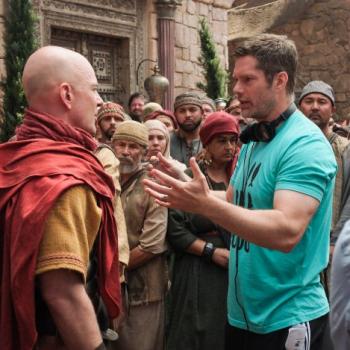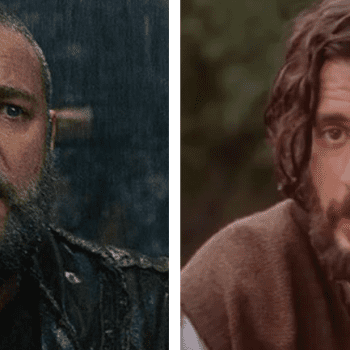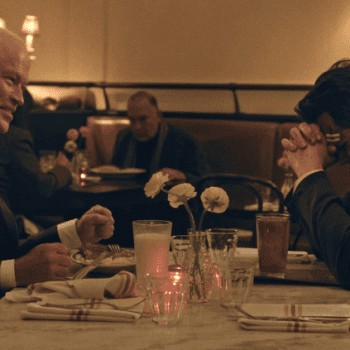Just got home from Sin City, Robert Rodriguez’s film adaptation of the comics by Frank Miller. Still processing it. And since my official review won’t be up for over a week, I have time to process it some more.
In a way, I shouldn’t have to process it. I have never read this particular series, but I did read a number of Miller’s other graphic novels back in the day, and he’s got a pulpy style that is interesting and anarchistic but doesn’t really invite much thought. He can be kind of visceral, but not in the sickening, forensic way that Alan Moore is; there’s a wildness, a craziness, to his comics that just bleeds — no, sprays — off the page, and whatever else we might say about this film, Rodriguez does capture that element very well.
FWIW, I remember liking The Dark Knight Returns and Batman: Year One a lot back in the late ’80s, and I loved Daredevil: Born Again when I got around to that one some years later, too. But my Miller appreciation took a serious dive when he wrote the screenplay for Robocop 2 — I loved the original Robocop and still do, but the sequel was a catastrophic mess, so much so that I didn’t even bother with the one that came after it, which Miller also wrote. Then again, he did write the Robocop Vs. Terminator mini-series, which was an interesting and creative attempt to bring my two favorite cyborg franchises together; and I developed a perverse interest in his Martha Washington series, which was fascinating not merely because it united Miller with Watchmen artist Dave Gibbons, but because of the way it married Miller’s chaotic ideas to Gibbons’s very precise draughtsmanship.
All of which is to say that, while I may not know any of the original Sin City storylines, I do recognize Miller’s style, and it’s all over this film.
In a way, that’s good, but in another way, it ain’t — this film tells something like five or six stories, some very short and some a little longer, and they all reflect that grim, morbid, sadomasochistic thing that Miller’s got going on, and while any one segment of this film might be an interesting watch in its own right, putting all of them together and sitting through them all in one go is a little much. You can only introduce, and then bump off, so many protagonists — and by that I mean the main character in any particular sergment — before it gets a bit wearying. And that’s before we take into account the sheer repetition of all the dismemberings, beheadings, and wounds to the male groin that take place over the course of this film.
Visually, this mostly black-and-white film is terrific, with the city itself looking like a monochromatic variation on those all-digital Sky Captain sets. I like the way the blood — and there is a lot of blood here — is given the red spot-colour treatment on some occasions, while on others it looks like bird droppings, a patch of white against someone’s black coat. I think there is even a scene of someone standing against a brick wall, and in the shadow, we see not simply a darker version of the rest of the wall, but more of a camera negative — dark bricks with white lines between them. Details like these nicely incorporate Miller’s visual style into the look of the film.
Some actors fit very well into this milieu, others less so. Mickey Rourke, of all people, is the stand-out as Marv, the ugly brute who is framed for the murder of a hooker who gave herself to him for free; he then tortures and kills as many people as it takes to avenge her death. I was startled and worried for Rourke when I saw the remake of Get Carter five years ago — it looked to me like he had taken enough steroids to kill a stable full of horses — but in this film, he’s one of the few actors who wears prosthetics on his face, and the added bit of freakishness actually makes him more human. His voice-over narration is pretty good, too. For my money, second place goes to Bruce Willis, who plays the only good cop in town, and whose stoic, years-long efforts to defend the life and honour of an 11-year-old girl are not repaid in quite the way he expected. He, too, does the voice-overs right.
I guess the only other major voice-over role goes to Clive Owen — come to think of it, yeah, it is only the men whose heads we get inside, here. The women are always something “other”. More often than not, the female characters are there because they need protection, the one glaring exception being the hookers who arm themselves to the teeth in order to fight back against the mobsters who are just itching to regain control of the prostitution business (the reason they don’t control it, at the moment, is because the cops have struck a “truce” with the hookers and have agreed to let them police the red-light district on their own; if the cops were to get involved, they would essentially be protecting the mob’s interests). And of course, the sight of skimpily-dressed streetwalkers toting swords and machine guns is intended primarily for the pleasure of male, not female, viewers — the point is not what the women think about all this, but how turned on Owen’s character is by the actions of his “warrior woman”, his “valkyrie”. It’s kind of like how we get good but brief glimpses of a couple lesbians’ naked breasts, but heaven forbid that we should see any of the male characters naked even when they are.
I’ll have to do some snooping to figure out which bits were directed by “special guest director” Quentin Tarantino. The film does feature a few of his alumni — namely Willis (Pulp Fiction, Four Rooms) and Michael Madsen (Reservoir Dogs, Kill Bill) — in addition to Rodriguez alumni like Elijah Wood (The Faculty, Spy Kids 3-D), Josh Hartnett (The Faculty) and Carla Gugino (all three Spy Kids); for that matter, the girl that Willis’s character tries to save is played by Makenzie Vega, whose big sister Alexa was one of the Spy Kids. (You know what? This just may be Rodriguez’s first film since El Mariachi — which is to say, his second film ever — that does not star Antonio Banderas and/or Salma Hayek.)
Anyway, that’s as much as I can say without checking my notes. Though I can already sense other tangents wafting back into my mind — like the way the senator played by Powers Boothe says true power comes not from a gun but from getting people to play along with your big lie. (“Powers” Boothe is talking about “power”? And hey, Mickey “Rourke’s” character ends up going after a Cardinal “Roark”? Were these actors hired for the sheer punworthiness of their names?) In Miller’s world, authority of any sort — whether of the church or the state — is the “big lie”, but once this deception has been ripped away, there is nothing to take its place but pure demonstrations of power … and, occasionally, an act of self-sacrifice. I’m still mulling over whether these acts of self-sacrifice tilt towards something redemptive or something more resigned and fatalistic. But perhaps they’re both.












